
When people ask me what I do I say that I find unconventional, out of the box, scalable and repeatable ways to gain new users, I hack growth.
Scalable meaning you can easily expand the reach of this campaign without having to spend too much extra resources. Repeatable meaning you can either automate parts of this process by writing a script and/or by hiring people to do it for you.
How is it different from traditional marketing?
A traditional marketing tactic might be to run a sponsorship campaign on NPR or to land the founder of a company a big interview in a national newspaper.
A growth hack might be to build a referral program or a get a bunch of popular blogs to link to your blog post.
Growth hackers experiment with different types of strategies to see how they can achieve a similar outcome as traditional marketing until they find the most effective least labor intensive approach. Then they automate every part of this approach.
I’ve been growth hacking for close to 10 years now, I’ve had some successes (most recently got a company acquired by Google). The following list is the most actionable and effective growth hacks which have worked for me, each growth hack below has the process and the result which was achieved.
Ready? Lets roll…
Hack 1: How I took a startup from 0 to 40,000,000 pageviews and got it acquired by Google
A few years ago I was asked to help market an app called Polar, an easy way to create and run a poll on your website. Two years later I was still the only marketer working at the company as we hit 40M+ pageviews and were acquired by Google.
When Polar launched we had 0 users and they were live in the app store. I needed to find a way to get tons of new users on the cheap, we did not have much money. As mentioned the app allowed you to make polls, soI asked myself:
“Why would people use polling software? In what context?”
“Who would want to actually use this? And why?”
“Where does it add value? And who is our target market?”
“How could we get the word out about Polar without spending a fortune?”
I tested all sorts marketing ideas: partnerships, referrals, buying traffic, cold emailing people, nothing seemed to work.
I needed a reason to get websites with lots of traffic to use our polling app. Why would somebody add a poll on a website? To increase engagement of the traffic that is coming to the site. Who has lots of traffic every day? Breaking news blogs and publications… Aha!
After months of experimenting with different strategies I had an idea:
Try pitch breaking news blogs to use our polls in their articles.2
It seemed natural to add a poll into a hot and trending article, would keep people on the webpage longer and engage them a bit more.
I decided to try and marry polls on our app with breaking tech news articles which I found on Techmeme, TechCrunch, Business Insider and others. My thinking was that every breaking news story should have our polls embedded or referenced in it; people would view and vote on the poll and potentially download our iOS app.
It’s much easier than getting them write an entire article about you.
If you try to adopt this approach for your startup it’s important to create a compelling reason why a journalist or influencer should mention your poll. What’s the value proposition for the journalist? In this case the value prop I sold them was: “Our polls drive more engagement for your article. You’ll get 200 votes vs 30 comments.”
Here is one of my cold email pitches to a journalist:
Subject: Got a poll for you: Which Foursquare logo do you prefer?
Hey Chris-
Made a poll for your article asking which Foursquare logo people like the best, check it, might be fun to get your readers more involved to get more to come back to the article:http://polarb.com/polls/194407
Here are how these polls look like live:
http://guycodeblog.mtv.com/2014/03/21/vote-favorite-melanie-iglesias-photos/
-Dmitry
Here is the process you should go through to replicate this hack:
Google the keyword which describes your startup, it can be your industry, your competitor’s name, anything which relates directly to what you do. Click the Google news tab to see recent articles written about this keyword. Let’s say you’re interested in “startup pr” here is what you get from Google News:
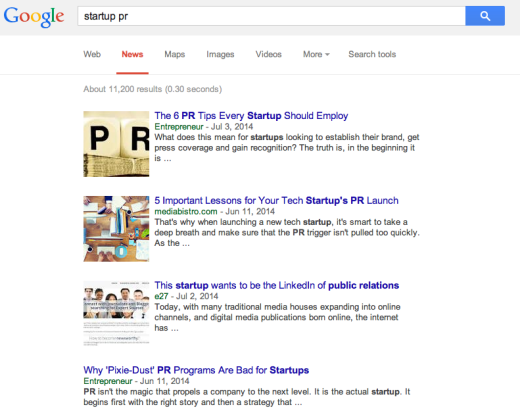
Take a look at each of the articles, write down the name of the reporter, the title of the article, and any notes about how this article fits with what you do. It’s best to do some extensive research about the person who wrote this article to make sure they are a good person to reach out to.
You can also do the same with a handy little tool called Buzzsumo, just type a keyword in and the tool will spit back the most shared articles matching your keyword:
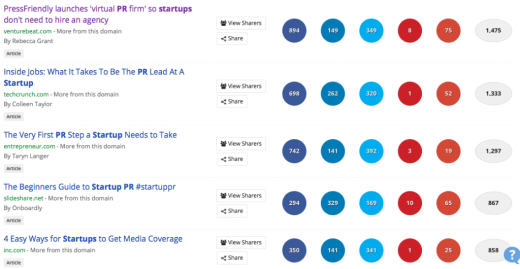
When you’re done compiling a decent size list of journalists and influencers it’s time to nail down why each one of them will find value in what you are pitching. This is the most important part of the hack, you have to show them real value with your pitch.
Read their bios on social media to see what their interests are and what type of niches they typically write articles on. Remove journalists that don’t write about your field very often. These people have to be a perfect fit.
I always say: “If you were standing next to them at a conference what would you say to get a conversation started?” If you’ve got nothing that would really kick off a genuine conversation take this person off your contact list.
The next step is to find their email address. Finding emails these days is super easy, most emails are in one of these following formats:
[email protected]
[email protected]
[email protected]
If these fail use EmailFormat.co, SellHack, or Voilanorbert these are the best tools out there. If you want to step up your game check out Dibbr these guys are absolute masters when it comes to cold email.
There is a slew of email templates you’d want to test out, there is no one fits all approach. Here is a good generic one to use as a placeholder:
Hey Steve,
I was just reading your article ‘Amazon Takes a Massive Leap Toward 100 percent Renewable Energy’ and thought [insert a controversial point about an article and share your opinion, pique their curiosity a bit, ask them a question.]BTW, I work at a company where we [insert your one sentence pitch, use http://fi.co/madlibs to perfect it]. We were recently featured/talked about in [insert a recent accomplishment]. We have some news coming out [feel free to insert a few words about the news], would love to share more info with you. Let me know if you’d be interested to hear more.
Thanks,
Dmitry
[insert full contact info]
The very last step is to automate this growth hack. There are a few nifty tools and scripts I love to use for this process, the entire automation process I use is outlined in this article How to Send Hundreds of Personalized Outreach Emails using Mail Merge in Gmail.
Hack 2: How to get 60 leads in 24 hours with LinkedIn and a landing page
I originally published this hack on KissMetrics blog and Entrepreneur magazine, the article was titled: How to Get 60 Leads in 24 Hours With a Landing Page and a LinkedIn Group.
The idea behind this hack is simple: find situations where you can help someone where it naturally leads to being able to ask for a promotion in return.
You start out by finding the most popular and active LinkedIn group or Facebook group for your target market. Let’s pretend your target market is CIOs so you find the following LinkedIn Group:
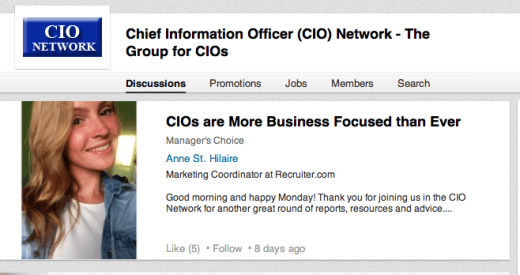
Now apply the rule of reciprocation, do something nice for the admin of this group to get the ball rolling. Reach out to the administrator of this group and ask to interview them for a guest article you’re writing for another popular blog in their industry or your own blog.
Interview the admin, do your best pitching the article to be published somewhere (you can use my technique here), publish the article, get some free promotion for the admin running the group.
You’re building a good rapport with the admin of the group, you’re doing something nice for them without asking for anything (at least not yet).
Now comes the fun part….
Find an old piece of content written by yourself or your team or write a new piece of content. This content must really engage the people in your target group. This is something that stirs folks up, gets them to reply and upvote and read at least 80 percent of what you’ve written.
I chose the following article for the CIO LinkedIn group above: Letter to the CIO of a Services Enterprise from the COO.
This article really engages members of this CIO LinkedIn group and this is exactly what you’re trying to achieve.
Create a PDF whitepaper out of your article, this is straightforward, here is the PDF of the Letter to CIO article above.
Create an Opt-in landing page for your PDF whitepaper, this is straightforward as well, just use UnBounce or Leadpages to do this. The goal of this page is to ask people to give their email address in exchange for the full PDF of your article. The final page will look and function like this.
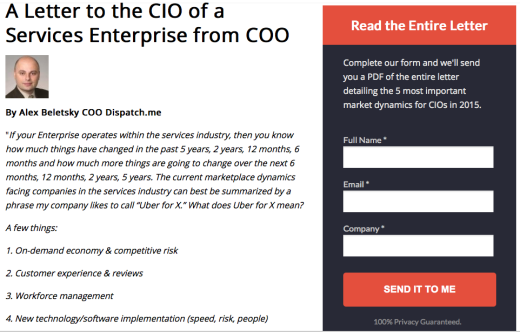
The idea is that you pull them in with the copy on the landing page and then try to get an email address out of them. So be very picky with the copy you have on this landing page.
The last step: email the admin of the group and ask them to promote your whitepaper/landing page. Since your whitepaper is a perfect fit for this group and you already helped the admin out it’s very likely that they would be down to promote the landing page you created within their group.
Here is a typical email draft to use:
Hi Jon-
Hope your Wed is off to a good start. I wrote the following whitepaper for your group, thought it would be engaging and a good fit for all the members. Would you be able to promote the following to your group?
http://try.dispatch.me/lettertocio/Thanks ahead of time,
-Your Name
Here is how the actual promotion looks within the group:
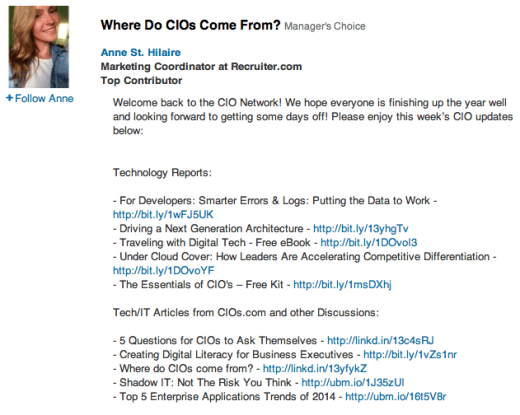
People click on the link to go to your page and put their email in to get the whitepaper emailed to them.
The admin promotes your landing page to the entire group, people who are interested in your whitepaper will give you their email in return for the full PDF of your article, you can then sort and filter all the people who gave you their email addresses to determine the best leads you can sell your product/service to.
Hack 3: How to go from 700 to 3,000 email subscribers in two months
Why is it important to grow your email list? Who cares about emails?
This diagram from Bryan of Videfruit is the best answer to this question:
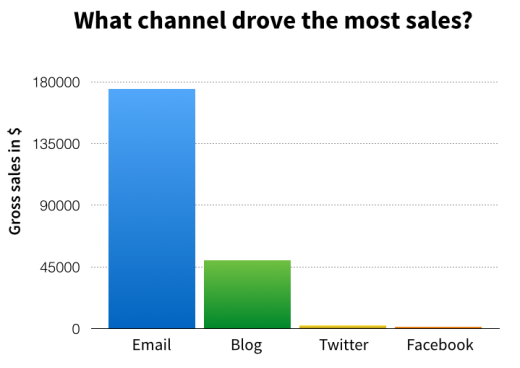
Here is what Bryan had to say about this graph above:
After 18 months of experimentation, I discovered that building a list was the most important thing to growing my business.
More so than traffic, Facebook likes, Twitter followers or comments on blog posts.
Simply put…
Email = Revenue.
This is my revenue (by sales channel) breakdown for 2014.
As Bryan rightfully points out later in his post:
Recognizing that building a list is important and ACTUALLY building a list are two very different things. Growing a list is freaking hard. Especially when there are so many other things vying for your attention.
In my last post titled How to Grow from 700 to 3,000 email subscribers in 2 months I detailed the very process I went through to grow my email list.
About 4 months ago I uncovered a new marketing strategy, I ripped this strategy off and installed it into my blog, my subscriber count went from 700 to 3000 in under 2 months.
What is this strategy? It’s called a Content Upgrade. These very content upgrades have completely changed my business allowing me to focus and rely on my blog for a very sustainable income.
In this post above I lay out a step by step of how I went from 700 to 3,000 subscribers. Bryan Harris of Videofruit is a good friend and has been an amazing coach, I look up to the guy, he is amazing. Here is how he uses his blog to build his email list:
Read about what content upgrade is and how to set it up
Check out this in-depth guide on creating your first content upgrade
Hack 4: How to launch an online course and make $220,750 in 10 days
I LOVE this hack. Bryan Harris of Videofruit is one of those people you know will succeed, he is persistent and almost never gives up. 18 months ago he did not have a blog, a few months ago he launched an online course to his 10,000 subscribers on his blog, this was his revenue:

He got 262 people out of 10,000 who subscribe to his blog to pay an average of $800 for an online course which took him around 500 hours to create.
Bryan outlines all the details and gives amazing resources in his detailed blog post, here are the basic steps to replicate this on your own:
Come up with the perfect topic for your course
Look at your Google Analytics under Behavior->Site content and on LeadPages, SumoMe or whatever tool you use for content upgrade to do the following:
*Make a list of your most popular blog posts (or podcasts or YouTube videos).
*Make a list of your most popular content upgrades.
Now do this:
Analyze the categories of your most popular posts and content upgrades to find the topic of highest interest.
Turn your most popular category into a product hypothesis.
Here is how Bryan did it, here is his most popular blog posts:
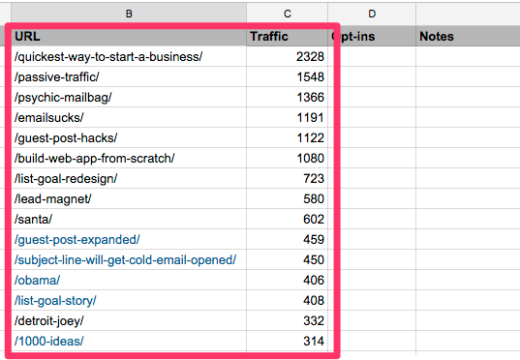
and here is his most popular content upgrades:
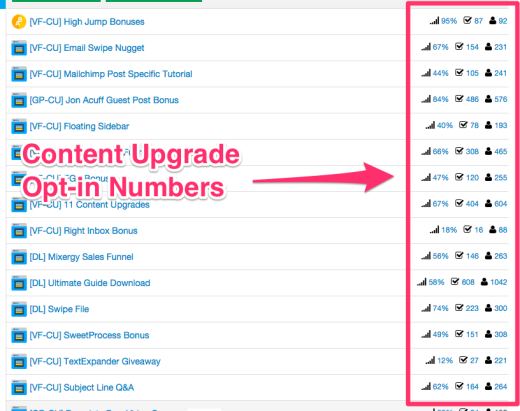
Analyzing this data he determined “list building” is the hottest topic of interest for his email subscribers, this is the topic that most of his email subscribers were interested in.
He created a Google doc and wrote down a thorough description of his online list building course, click here to view this Google doc.
Get people to pay you money before creating the course
Here is how Bryan did this:
Step #1: Segmented off a small part of my email list that had previously expressed interest in the topic of the course.
Step #2: Sent a copy of my product hypothesis to them and asked for their feedback.
Step #3: I immediately sent a pre-order link to anyone who answered that they would buy the course.
My goal was to get at least 10 percent of the focus group to pre-order the course.
If I succeeded, then I would make the product.
If not, I would pivot and either abandon the idea, pick another topic or adjust the product hypothesis based on the feedback I received.
Here is the introduction email he sent asking if people wanted to participate in his course:

Here is the follow up:
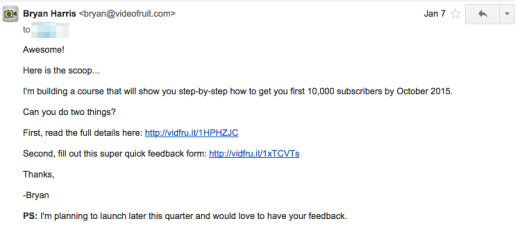
The key question Bryan asked in the survey is: “Do you want to buy the course?”
Anyone who answered YES to that question got another email from him thanking them and giving them a pre-order link for the course.
Bryan repeated this process with multiple groups of his readers who previously expressed interest in the topic of list building by downloading a content upgrade on that topic.
Of the 225 people included in the 3 testing rounds, 39 pre-ordered the course. Wild!
Build the course as fast as possible
Now he needed to build the course as fast as possible, there is a TON of info and resources involved in putting together a kick ass online course, as mentioned it took him 500+ hours to put together his course. You can read all about how to build an online course here.
By this point the hard part was already done, he had a list of email subscribers who wanted the online course he had built, some already pre-ordered it. All he needed to do is launch the course to his email subscribers through email. He spent 500+ hours building the course and about 12 hours actually launching it.
Launch the course to your email list
Here is Bryan’s email sequence for launching the course to his email list:
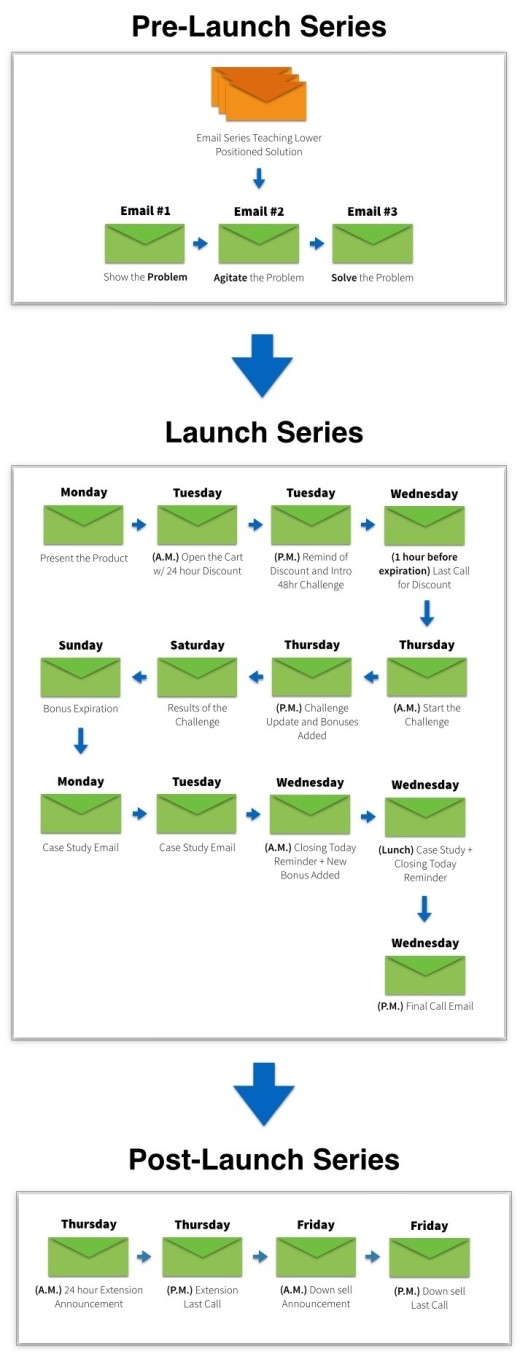
There is a TON of PAS formula applied and baked into these emails. Bryan is a master at this:
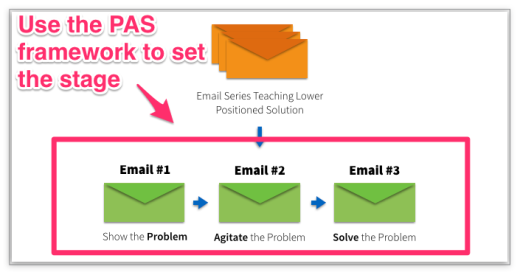
Here is how he did this:
Email #1: Problem: In this email I told a personal story and used it to highlight two of the main drawbacks of a service-based business.
Email #2: Agitate: In this email I quickly recapped the first email and then went on to share 5 more mistakes you need to avoid when starting your business. No solutions were offered.
Email #3: Solve: In this email I recapped the first two emails, introduced my solution to the problems and mistakes from the first two emails (building an email list) and then taught a quick strategy that readers could use right then to start building their list.
There is a TON, and I mean a 7,500+ words of detailed and meaty examples of how Bryan launched the course to his email list and generated over $200K in revenue in his post I love love love this hack! Did I mention this is one of my favorites?
Hack 5: How I got 6.2 million pageviews and 144,920 followers
Writing a blog post which gets tons of views is really freakin’ tough. Ali Mese wrote an amazing post titled How I Got 6.2 Million Pageviews and 144,920 Followers in which he details the exact steps he went through to get this result.
This does not mean you need to do the same but it does mean that you can adopt some of these methods to get more people to read your blog posts.
Ali breaks down his process into four parts:
Part 1 — Before writing: Preparing for the storm & Setting the right engines in place.
Part 2 — Writing: Writing style and essentials of an article that will get huge traffic.
Part 3 — Ready to publish: Things to do when you are ready to hit the publish button.
Part 4 — Post-publishing: How to get into big media outlets, how to double your blog traffic with redistribution, and some other channels no one thinks of.
Most of the trickery and hackery comes in in Part 4 so let’s break some of these hacks down:
Reproduce the same content on different channels and in different formats
This is something that generates significant additional traffic. Once you see that an article is successful, turn it into a new format in a new channel.
Ali turned his articles into slides and uploaded them to Slideshare, he also turned them into images on Instagram and Facebook, infographics on Pinterest, and videos on YouTube.
The best result hands down was when Ali turned this article into this content productwhich got thousands upvotes on Product Hunt.
Redistribute your content on other blogs and publications
Ali pitched big media blogs to republish his article. Republishing your blog post on big publicaitons ca sometimes double your traffic. Here are all the outlets he pitched and actually got to republish content he has written for his own blog:

Most outlets want great content on their websites and are open to having yours republished on their site if it’s quality content, here is Ali:
The truth is, editors working for big media outlets are such nice people. They are not your enemies, and they don’t ignore you on purpose.
They usually have very intense workloads and they need one thing: to bring only the best content to their websites.
Ali went on contact pages of his target publishers or tech blogs and got the emails of editors. When there’s no email he searched for them on Twitter. He put together his wish list of target editors with all their contact details. (Take a peek at Hack #1 above to see how to guess anybody’s email)
Before reaching out Ali made sure he had traction. Editors want to see impressive analytics or traction as proof that your article is doing great. You might have to wait for a few days to get some analytics data, once you see some good traction take a screenshot of it to include in your email.
Here is the typical email Ali send which usually received an answer:
Subject: My post has 42 percent share rate, screenshot attached, repost maybe?
Hi, my article is performing really well, pls see analytics data attached. I want to repost it on your outlet. Please kindly get back if you are interested.
Ali
Ali also mentions that sometimes republishing the article on another publication is not the right channel for it, it might take weeks to find the best channel to re-promote it. It took weeks for this article Ali wrote to find the right channel before someone uploaded it on Reddit and StumbleUpon and it exploded virally on Facebook:

There is a ton of awesome little hacks to get more exposure for your blog post Ali lists in his article, feel free to read through it, it’s a great read. Remember that after you write amazing content there is a slew of ways to get get a ton more exposure from it.
Hack 6: 36,282 readers + 1,000 email subscribers from one blog post
Back in June of this year I read an article on Brian Dean’s Backlinko about this guy Jimmy who used something called a Skyscraper Technique to write a blog post and got 30k pageviews, 1k email subscribers, and currently ranks #2 for his target term.
I was very impressed so I read on. The strategy he used was simple but not easy, I decided to give it a try myself. In 14 days I was able to rank #3 on Google for my keyword, I wrote an article of what I did step by step.
Here is how skyscraper strategy works:
Here are the main steps:
Step 1 – Discover awesome content
Find an article which is currently ranking at the top of Google search results for a keyword you want to rank for. This article must be super-relevant to your target demographic, it should be directly related to your industry. As Brian points out: if you run a dog blog, you’d want to look for popular content about dogs. Simple.
Step 2 – Improve the content you found in step 1
Your job is to write and publish a superior version of the content you found in step 1.
Make it longer – In my case when I decided to write a longer blog post I saw that there already was a post titled “35 Growth Hacking Tools“, so I decided to write a post which was 50 Growth Hacking Tools. I think if I had more time I would go for “100 Growth Hacking Tools” – this would for sure blow everyone out of the water.
More Up-To-Date – There is tons of content out there that is just plain old and out of date. Make your content most up to date out of all the ones you see above. Websites and blogs which look like they’re from 2003 should not be outranking you on your keyword.
Better Designed – Plain and simple your blog post needs to have a nice and clean design. A lot of times a visually stunning piece can generate a lot more links pointing to it.
Step 3 – Reach out to people who backlinked to original article ranking high for your keyword
Take the article you found in step 1 and use OpenLinkProfiler to see who has linked to this article, make sure to sort the results by Link Influence Score, here is what you get:
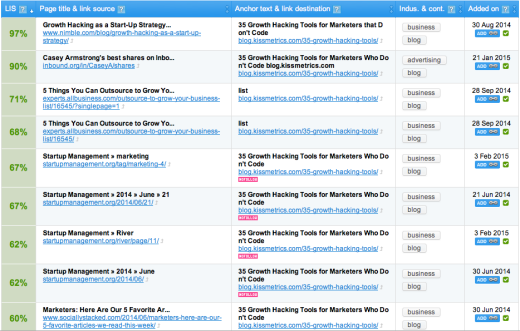
You want to reach out to these blog owners and ask them to link to your new blog post you published in step #2 above. Here is the email template I use to reach out:
Hey [Name],
I was searching for some articles about [Your topic] today and I came across this page: [URL]
I noticed that you linked to one of my favorite articles: [Article Title]
Just wanted to give you a heads up that I just wrote a similar one. It’s like [Name of the article] but more thorough and up to date [URL].
Might be worth a mention on your page.
Either way, keep up the awesome work!
Cheers,
-Dmitry
Hack 7: How Udemy found their first 1,000 instructors through cold emailing
When you first start off, it can be difficult to gain traction because nobody has heard of you. At this point, it is difficult to leverage some of the other growth hacks that require at least a small user base.
You probably heard of Udemy, a company which has raised $113M in 5 rounds of funding and have tens of millions of users currently. Back when they were nobody and we struggling to get their first 50 users Gagan Biyani ran a a cold email campaign that netted Udemy’s first users. There is a great article written about this titled: How Udemy Found Their First 1,000 Instructors… Tips For Building a Marketplace with Gagan Biyani
Udemy is a website where experts record courses and sell those course to students. Imagine trying to convince experts to spend 10+ hrs creating a course for a website which has virtually no audience, not easy!
Biyani began by creating a course on Udemy himself to show other instructors how much they could earn on the site. Then he hired people on Odesk $3/hr to find qualified leads to put up more courses of their own on Udemy.
Let’s say Biyani wanted to find instructors for teaching Photoshop, he wanted people to register on Udemy and record a high quality course about Photoshop.
He told the people he hired on ODesk to Google the term “learn Photoshop” and other terms related to learning Photoshop. Everyone who wrote about this topic would be a perfect instructor on Udemy. so he told the ODesk folks to create a list of everyone who shows up on first page of Google for “learn Photoshop”.
Biyani started off by writing cold emails to each blogger or influencer on the list he got back from Odesk. He tracked which emails got best responses. He chose the winning emails and used those to email new prospective leads he would get from data scrapers he hired on ODesk.
This cold email outreach to Photoshop experts to ask them to record a course about Photoshop on Udemy worked pretty well, people responded. The major problem was that most instructors who started to record a course failed to finish it so Biyani came up with this follow up email:
Hey, we wanna run a promotion for your course in 3 weeks…can you get it down by then?
This email worked like wonders and most instructors finished their courses without a problem. Biyani repeated this same strategy for all the other industries and verticals to get more instructors to record high quality courses for Udemy.
Speaking of cold emailing to score new customers Iris Shoor cold emailed people a bunch of prospective customers to introduce them to a new product she was building called Tapiki. Her cold emails ended up getting her meetings at Twitter, LinkedIn and Github.
Here is the cold email Iris used:
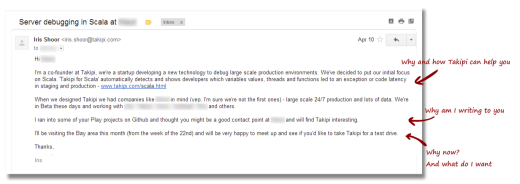
Hack 8: How PayPal achieves 7-10 percent daily growth and reached over 100 million users
Referral Candy published an Epic List of 47 Referral Programs which lists the very best referral programs which are solely responsible for initial growth behind companies such as Dropbox, Airbnb, Paypal, Uber, Evernote, Amazon, etc. This blog post is pure gold.
Incentivized referrals have been used by many startups to seed their organic growth. Paypal pioneered this model back in the day, they offered $10 to the referrer (someone who referred someone to the service who ended up signing up) and $10 to the new customer (who was referred and signed up).
Both sides benefited and that’s why it worked so well. This model presented incentives for both sides to take action. Paypal achieved 7-10 percent daily growth and reached over 100 million users during this promotion.
Here’s an excerpt from Peter Thiel’s CS183 startup class describing how PayPal tried advertising but ultimately found $20 for each new customer to be the most cost effective growth tactic:
PayPal’s big challenge was to get new customers. They tried advertising. It was too expensive. They tried BD deals with big banks. Bureaucratic hilarity ensued. Over ice cream, the PayPal team reached an important conclusion: BD didn’t work. They needed organic, viral growth. They needed to give people money.
So that’s what they did. New customers got $10 for signing up, and existing ones got $10 for referrals. Growth went exponential, and PayPal wound up paying $20 for each new customer. It felt like things were working and not working at the same time; 7 to 10 percent daily growth and 100 million users was good. No revenues and an exponentially growing cost structure were not. Things felt a little unstable. PayPal needed buzz so it could raise more capital and continue on. (Ultimately, this worked out. That does not mean it’s the best way to run a company. Indeed, it probably isn’t.)
Incentivized referrals is a great way for a new company to build a large user base in a short period of time. However, the costs do add up over the long term so keep your eyes closely on your customer acquisition costs versus their lifetime value. When your acquisition costs begins to significantly exceed their lifetime value and your coffers are running low, it may be time to pull the plug on your generous offer.
Hack 9: How Twitter, Facebook and LinkedIn use onboarding to engage their new users
A close friend of mine recently pinged me with the following email:
We just hit 300,000 registered users on our app, we need to get to 500,000 by the end of Q3 to keep investors happy. We want to secure another round of funding soon. Can you help us think through how we do this?
I can’t tell you the name of the app but I can say that these guys have a three percent conversion rate to active users which is pretty bad. Three percent of everyone who signs up actually uses this app.
Now they can try to focus on getting 200,000 new signups or they can just increase the conversion from three to 10 percent. If they focus on conversion all the future traffic they get won’t leak out of their funnel as steadily either.
People often focus all their energy on getting as many users signed up as possible. However, they completely forget about how many of those are actually ACTIVE users. Or godforbid paid users!
Once you know you can convert 10 percent of your traffic you’re set. You can go and buy more traffic and build a sustainable business. Most people forget about the bottom of the funnel, they forget about conversion.
Onboarding is #1 driver behind user engagement of any product, this is the process which every new user must go through and it either makes or breaks an engaged user. There is a great article titled Onboarding New Users Is Harder Than You Think which gets into the details of this problem.
A while back Twitter had a bit of an issue, a lot of their new users did not engage with the product during initial onboarding and as a result became inactive. They decided to figure out what actions do their users need to perform within their product to become engaged.
After studying their analytics, Twitter found that users were more likely to stay active if they followed more than 30 people. So as part of their onboarding process, Twitter decided to recommend a lot of people for you to follow:

Facebook found that a CRUCIAL part of making sure you become an engaged user is that you find your friends on their platform, so it’s a big must part of their onboarding:
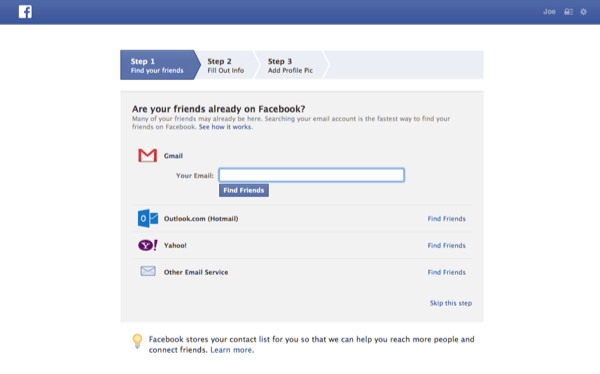
LinkedIn found that making sure you follow influencers plays a major role in whether you become engaged since if you follow them you would want to check to see their updates so it’s part of their onboarding:

So how do you actually apply this hack? You should study your own product to see what steps your most active users took. Then during your onboarding process, you can guide your new users to take those very steps.
Remember it’s the engaged users who grow your business, not raw traffic coming to your site.
Hack 10: Effective tiny growth hacks I employ as a rule of thumb
Just McGill over at SEJ published a killer list of 100 Growth Hacks some of which area actually pretty good and many of which I’ve used for years, for this last section of the post I am going to list the little hacks I employ all the time as a rule of thumb:
Comment on Quora, Slideshare and blogs
Commenting on relevant content is the best way to connect with influencers in your field. If an influencers if putting a message out, the first people to comment on that message usually get most response.
There is a nifty little tool out there called Colibri which finds the blogs and Quora threads you should comment on to get noticed by influencers in your field. I also like LittleBird which helps you narrow down which influencers you should connect with and reply to out to on Twitter.
Add hellobar and exit intent to your website
This is a no brainer, it has a potential of tripling the rate at which your email subscribers give you their emails. I use SumoMe and LeadPages for Hellobar and exit intent.
Pay for trtiber influencers
There is a TON of influencers or people who have huge followings hanging out on Triberr. The traffic I’ve gotten from this site to come over to my site stays on my blog an average of 4 minutes which is really good! I use Fiverr to get someone to promote my blog posts on Triberr for $5. Be careful not to get some spammy hacker, do you research, the quality on Fiverr can be pretty bad.
Require shares for your best content
If I have a blog post of high quality content that has proven to be popular and frequently read I like to use Pay With A Tweet to require people to share the post in order to access it.
Old tools that no longer exist
This is an old trick!
Search for blogs about products in your space. If there are products listed that don’t exist anymore, email the author telling them that this product no longer exists. Suggest replacing this product which does not exist with your product and provide a brief description and link, or at least try getting your product added to the list.
That is all! 6000+ words about the most effective growth hacks I’ve used and continue to use today. I hope you liked the list, if you have any good ones which worked for you please don’t hesitate to share.
631 students are currently taking this course, feel free to peek at the course here.
Read Next: How I grew from 700 to 3,000 email subscribers in 2 months
Image credit: Shutterstock
This post first appeared on Criminally Prolific.
Get the TNW newsletter
Get the most important tech news in your inbox each week.




